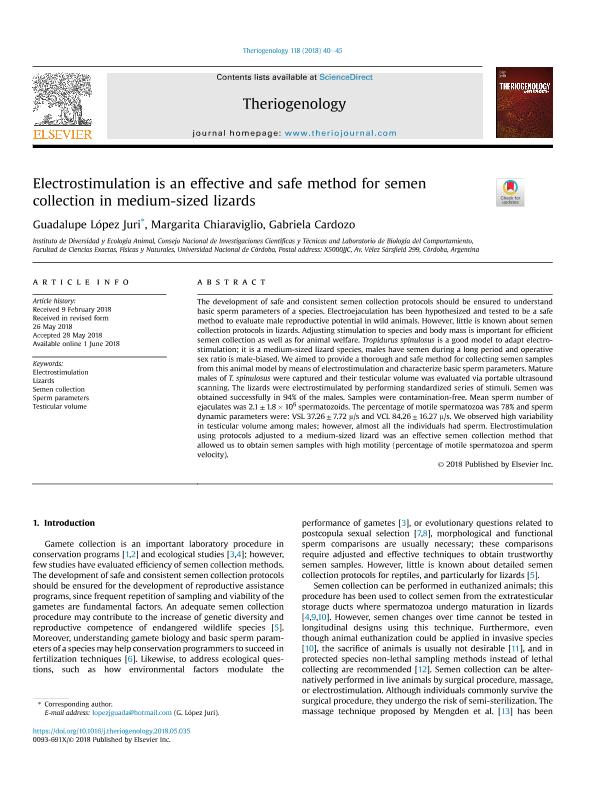Mostrar el registro sencillo del ítem
dc.contributor.author
López Juri, Guadalupe

dc.contributor.author
Chiaraviglio, Margarita

dc.contributor.author
Cardozo Milanesio, Gabriela Alejandra

dc.date.available
2019-11-12T13:37:21Z
dc.date.issued
2018-09
dc.identifier.citation
López Juri, Guadalupe; Chiaraviglio, Margarita; Cardozo Milanesio, Gabriela Alejandra; Electrostimulation is an effective and safe method for semen collection in medium-sized lizards; Elsevier Science Inc; Theriogenology; 118; 9-2018; 40-45
dc.identifier.issn
0093-691X
dc.identifier.uri
http://hdl.handle.net/11336/88577
dc.description.abstract
The development of safe and consistent semen collection protocols should be ensured to understand basic sperm parameters of a species. Electroejaculation has been hypothesized and tested to be a safe method to evaluate male reproductive potential in wild animals. However, little is known about semen collection protocols in lizards. Adjusting stimulation to species and body mass is important for efficient semen collection as well as for animal welfare. Tropidurus spinulosus is a good model to adapt electrostimulation; it is a medium-sized lizard species, males have semen during a long period and operative sex ratio is male-biased. We aimed to provide a thorough and safe method for collecting semen samples from this animal model by means of electrostimulation and characterize basic sperm parameters. Mature males of T. spinulosus were captured and their testicular volume was evaluated via portable ultrasound scanning. The lizards were electrostimulated by performing standardized series of stimuli. Semen was obtained successfully in 94% of the males. Samples were contamination-free. Mean sperm number of ejaculates was 2.1 ± 1.8 × 106 spermatozoids. The percentage of motile spermatozoa was 78% and sperm dynamic parameters were: VSL 37.26 ± 7.72 μ/s and VCL 84.26 ± 16.27 μ/s. We observed high variability in testicular volume among males; however, almost all the individuals had sperm. Electrostimulation using protocols adjusted to a medium-sized lizard was an effective semen collection method that allowed us to obtain semen samples with high motility (percentage of motile spermatozoa and sperm velocity).
dc.format
application/pdf
dc.language.iso
eng
dc.publisher
Elsevier Science Inc

dc.rights
info:eu-repo/semantics/openAccess
dc.rights.uri
https://creativecommons.org/licenses/by-nc-sa/2.5/ar/
dc.subject
ELECTROSTIMULATION
dc.subject
LIZARDS
dc.subject
SEMEN COLLECTION
dc.subject
SPERM PARAMETERS
dc.subject
TESTICULAR VOLUME
dc.subject.classification
Zoología, Ornitología, Entomología, Etología

dc.subject.classification
Ciencias Biológicas

dc.subject.classification
CIENCIAS NATURALES Y EXACTAS

dc.title
Electrostimulation is an effective and safe method for semen collection in medium-sized lizards
dc.type
info:eu-repo/semantics/article
dc.type
info:ar-repo/semantics/artículo
dc.type
info:eu-repo/semantics/publishedVersion
dc.date.updated
2019-10-16T14:24:35Z
dc.identifier.eissn
1879-3231
dc.journal.volume
118
dc.journal.pagination
40-45
dc.journal.pais
Estados Unidos

dc.description.fil
Fil: López Juri, Guadalupe. Consejo Nacional de Investigaciones Científicas y Técnicas. Centro Científico Tecnológico Conicet - Córdoba. Instituto de Diversidad y Ecología Animal. Universidad Nacional de Córdoba. Facultad de Ciencias Exactas Físicas y Naturales. Instituto de Diversidad y Ecología Animal; Argentina
dc.description.fil
Fil: Chiaraviglio, Margarita. Consejo Nacional de Investigaciones Científicas y Técnicas. Centro Científico Tecnológico Conicet - Córdoba. Instituto de Diversidad y Ecología Animal. Universidad Nacional de Córdoba. Facultad de Ciencias Exactas Físicas y Naturales. Instituto de Diversidad y Ecología Animal; Argentina
dc.description.fil
Fil: Cardozo Milanesio, Gabriela Alejandra. Consejo Nacional de Investigaciones Científicas y Técnicas. Centro Científico Tecnológico Conicet - Córdoba. Instituto de Diversidad y Ecología Animal. Universidad Nacional de Córdoba. Facultad de Ciencias Exactas Físicas y Naturales. Instituto de Diversidad y Ecología Animal; Argentina
dc.journal.title
Theriogenology

dc.relation.alternativeid
info:eu-repo/semantics/altIdentifier/url/https://linkinghub.elsevier.com/retrieve/pii/S0093691X18302723
dc.relation.alternativeid
info:eu-repo/semantics/altIdentifier/doi/http://dx.doi.org/10.1016/j.theriogenology.2018.05.035
Archivos asociados
